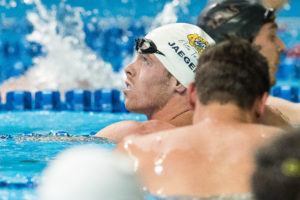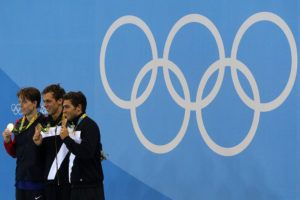One of the oldest debates in the scientific community is whether a behavior is inherited or acquired. ‘Nature,’ is what we think of as pre-wiring and is influenced by genetic inheritance. ‘Nurture,” is generally thought of as the influence of external factors, such as the product of exposure, experience, and learning.
The sporting community is by no means immune to this debate, which creates some of the most polarizing opinions about what aspects play important roles in an athlete’s athletic evolution. I can understand why this resonates with people. It’s hard to deny that Ethiopian runners, who train in high altitude and heat, aren’t influenced by their surroundings. In addition, when looking at the Manning family, the argument of ‘nature’ understandably makes intuitive sense. The waters here can get quite murky.
 Believe what you will, but Connor Jaeger, Team USA distance-swimming superstar, grew up in an aquatic household. His introduction to the water began at an abnormally young age, not because of his own interest, but rather his parents’ want for safety. In Fair Haven New Jersey, Connor and his sister were always at the beach – “surf rats” as he describes it. Since his love for the water started at an early age, his parents signed him up to swim at the Surfrider Beach Club in Seabright New Jersey. At the age of 6, Connor struggled to swim a full 25-yard lap (which he laughs at now). “The ‘big kids’ had to go in the middle and hold the noodle for us. This was my first experience with competitive swimming,” Jaeger mentioned. “Then somewhere along the lines, someone suggested to my parents that my older sister and I should try-out for a year-round team.” From there, swimming became ingrained in Connor and he seemed to naturally gravitate to his predisposed proclivity toward the water.
Believe what you will, but Connor Jaeger, Team USA distance-swimming superstar, grew up in an aquatic household. His introduction to the water began at an abnormally young age, not because of his own interest, but rather his parents’ want for safety. In Fair Haven New Jersey, Connor and his sister were always at the beach – “surf rats” as he describes it. Since his love for the water started at an early age, his parents signed him up to swim at the Surfrider Beach Club in Seabright New Jersey. At the age of 6, Connor struggled to swim a full 25-yard lap (which he laughs at now). “The ‘big kids’ had to go in the middle and hold the noodle for us. This was my first experience with competitive swimming,” Jaeger mentioned. “Then somewhere along the lines, someone suggested to my parents that my older sister and I should try-out for a year-round team.” From there, swimming became ingrained in Connor and he seemed to naturally gravitate to his predisposed proclivity toward the water.
As Connor entered high school, he wasn’t quite sure if this sport was right for him. He said he seriously teetered on the fence about the sport. “There were times that I thought I wanted to quit, actually, it was all the time. But they were for dumb reasons,” he said. “So looking back at it, I’m obviously glad I stuck with it.” During Connor’s high school career, his approach to training strictly revolved around practice. As with many high school athletes, understanding that the nuances of training extend beyond the scope of practice is vital, but often lost.
 Upon high school graduation, Connor became a member of the University of Michigan swim team where prestigious alumni like Michael Phelps and Tom Dolan had competed. This was the defining step in Connor’s career where his training and overall approach to swimming adapted. “In college, I became a 24-hour athlete. Everything that I was doing was all about how it was going to affect my next practice,” he said. “As I got to practice at 6am, I constantly thought about how my body would be prepared for my next practice.”
Upon high school graduation, Connor became a member of the University of Michigan swim team where prestigious alumni like Michael Phelps and Tom Dolan had competed. This was the defining step in Connor’s career where his training and overall approach to swimming adapted. “In college, I became a 24-hour athlete. Everything that I was doing was all about how it was going to affect my next practice,” he said. “As I got to practice at 6am, I constantly thought about how my body would be prepared for my next practice.”
Connor’s typical training involved long strenuous practices of grueling aerobic workouts, early mornings, and self-induced sprints from class to class. “My hardest training days are Mondays. I wake up at 5:15am and swim 2 hours packed with kicking and aerobic drills. Since I was in college during most of my training I’d have to then rush to my 9am class. After class, we’d do long-rep threshold workouts of 800 meters where we would hold our fastest possible pace.”
In total, Connor swims 15-16 kilometers every Monday in addition to out-of-water exercises. This equates to 5 hours of training, on top of his coursework. Don’t forget that.
In 2012, Connor got his first shot at the Olympics. “My intention was to represent Michigan well,” he said. In the final of the 1,500-meter freestyle, Connor placed sixth with a time of 14:52.99. This was an incredible feat considering he broke 15-minutes in his first international event and was only a sophomore in college representing his country on the world stage.
Training & Recovery
An Olympic training regimen consists of 24/7 preparation, strict dieting, going to bed early, waking up before the sun, and putting their sport ahead of everything else. Now imagine doing all that while studying as an undergraduate in college? The importance of balancing training and recovery becomes even more vital for an athlete’s success in this situation.
“I was always up late and was always hustling from one thing to another. I’d be running out of the pool trying to get to my 8am class; trying to squeeze my lunch in and trying to find time for recovery. I’d have to find time even if I had to sacrifice something in the middle of the day so I could get to bed before 11pm.”
Being On WHOOP
Now that Jaeger is a member of Team WHOOP, he’s adapted his mental and physical approach to training. “While using WHOOP, I’ve been able to actually score my recovery every night, so I now know the things during my day that are affecting my sleep and recovery.”
With WHOOP data, Connor has been able to optimize his routine in a way that’s allowed him to feel more rested on a regular basis. “I was an engineer in college so I appreciate the data. I can now confidently say that whatever I did yesterday benefited me today and there is a reason why I feel this way. It’s all about being smart and using the details to achieve peak performance.”
“I’m looking for that 1% change. I’m looking for that .01 second in a race that will make me better. I’m looking for anything. I’ve done a lot of changing in the pool and I’ve done a lot of changing on dry land with mobility. Sleep is one way we can make changes that we never thought of.”
Connor’s approach to training and recovery goes against the ‘old school’ style of grinding for as long as you can, followed up by a long rest. His training is now more of a partnership between training and recovery by breaking it up into manageable bite-sized chunks.
“If you take a step with your right foot, you can’t take another step with your right foot before you take a step with your left. Training and recovery are a partnership.”
This is written by and courtesy of Todd Stewart and The Locker powered by WHOOP.
The 2016 Rio Olympics
Connor Jaeger is the first American to medal in the 1500-meter freestyle event since Larsen Jensen in the 2004 Athens games. He took control of silver half-way through the 1500-meter freestyle, and in the process, ended up breaking his own American record.
“I watched USA really crush it this week,” Connor said. “It was time for me to hold up my end of the bargain. I wanted to contribute to the medal count. I was thinking about it the whole time.”
In the final race of his last Olympic meet, Jaeger swam a very methodical and strategic swim which he had, in my eyes, secured from the second he dove in. Never once did he panic when Italy’s Gregorio Paltrinieri stormed to the lead.
Paltrinieri, the gold medal winner, flirted with the world record early in the race but slowed at the end.
“Gregorio really took off,” said Jaeger. “You just don’t know what’s happening. Am I going slow? Thankfully, he was just going really fast. It was comforting to know no one else went with him. To kind of remain in the pack and have him go do his own thing, it allowed me to stick to my race strategy.”
“I just went into this race saying crazier things have happened than me medaling in this race,” Jaeger told NBC. “I really couldn’t have looked for a better source of inspiration than my teammates this whole week.”
Swimming news is courtesy of WHOOP, a SwimSwam partner.

Great story. It all looks so easy at the moment of the big race. Most people have no idea of the daily grind that makes a great athlete. Thanks for sharing.